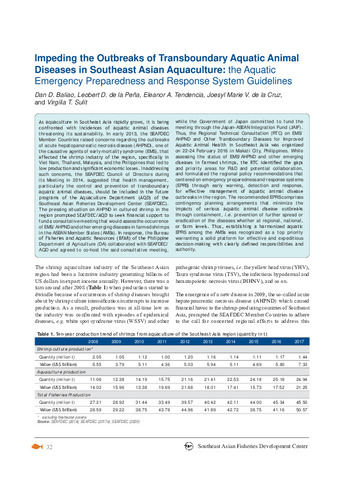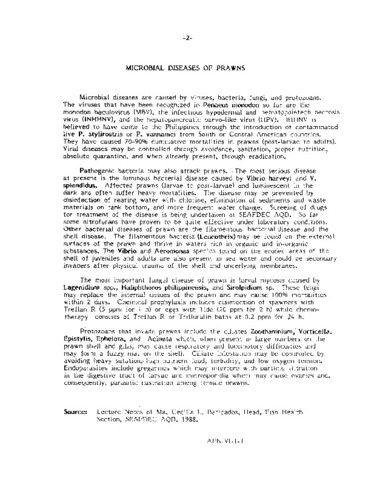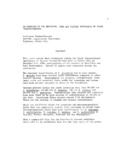| dc.contributor.author | Caipang, Christopher Marlowe | |
| dc.contributor.author | Trebol, Kathleen Mae P. | |
| dc.contributor.author | Abeto, Marian Jill S. | |
| dc.contributor.author | Coloso, Relicardo M. | |
| dc.contributor.author | Pakingking, Rolando | |
| dc.contributor.author | Calpe, Adelaida T. | |
| dc.contributor.author | Deocampo Jr., Joel E. | |
| dc.contributor.editor | Ferrer, Alice Joan | |
| dc.date.accessioned | 2023-03-10T08:26:52Z | |
| dc.date.available | 2023-03-10T08:26:52Z | |
| dc.date.issued | 2022 | |
| dc.identifier.citation | Caipang, C. M. A., Trebol, K. M. P., Abeto, M. J. S., Coloso, R. M., Pakingking, Jr., R. V., Calpe, A. T., & Deocampo, Jr., J. E. (2022). Innofloc: Innovative biofloc technology for the nursery production of shrimp, Litopenaeus vannamei in tanks. In A. J. G. Ferrer (Ed.), Proceeding of Joint International Conference of the Sixth International Conference on Fisheries and Aquatic Sciences (ICFAS 6) and Asian Fisheries Social Science Research Network Forum One (AFSSRN F1), 24-26 November 2021, via Zoom, Miagao, Iloilo, Philippines (pp. 241–245). University of the Philippines Visayas. | en |
| dc.identifier.isbn | 9786218285125 | |
| dc.identifier.uri | http://hdl.handle.net/10862/6419 | |
| dc.description.abstract | Nursery systems are valuable production tools in shrimp aquaculture and are effective biosecurity facilities for the high-density culture of shrimp postlarvae (PL), resulting in healthy and uniform-sized juveniles. The nursery production of shrimp is usually carried out in small ponds; however, the use of small and circular tanks with plastic liners is gaining popularity. From an industry standpoint, there is a need to assess how nursery systems can improve the productivity of the shrimp production cycle. Hence, the use of small circular tanks coupled with the incorporation of biofloc technology was assessed in terms of its viability during the nursery production of the Pacific whiteleg shrimp, Litopenaeus vannamei. A 450m2 plastic-lined circular tank was installed and prepared for the stocking of L. vannamei postlarvae (PLs) at a density of 500 PLs per m2. Biofloc was produced and maintained throughout the nursery phase by adding brown sugar as a carbon source at carbon to nitrogen (C:N) ratio of 10. Daily monitoring of the various water quality parameters was carried out, while presumptive Vibrios were enumerated weekly. The shrimp juveniles were sampled for their body weight on the 14th day post-stocking and weekly until harvest on the 30th day of culture. The different water quality parameters were within optimum levels required for shrimp growth. Presumptive Vibrios were dominated by the yellow colonies. The shrimp attained 100% survival with an average body weight of 1.26 g and a feed conversion ratio (FCR) of 0.43 at the end of the nursery production phase. Our results indicate that the use of small circular tanks with biofloc during the nursery production phase of whiteleg shrimp is feasible and can be incorporated during the grow-out culture for improved and continuous production of this shrimp species. | en |
| dc.description.sponsorship | Department of Science and Technology (DOST) through the Science for Change Program (SC4P) – Collaborative Research and Development to Leverage Philippine Economy (CRADLE) for the funding and the Philippine Council for Agriculture, Aquatic and Natural Resources Research and Development (PCAARRD) for assisting and monitoring the project activities. | en |
| dc.language.iso | en | en |
| dc.publisher | University of the Philippines Visayas | en |
| dc.subject | Penaeus vannamei | en |
| dc.title | Innofloc: Innovative biofloc technology for the nursery production of shrimp, Litopenaeus vannamei in tanks | en |
| dc.type | Conference paper | en |
| dc.citation.spage | 241 | en |
| dc.citation.epage | 245 | en |
| dc.subject.asfa | shrimp culture | en |
| dc.subject.asfa | biofloc technology | en |
| dc.subject.asfa | water quality | en |
| dc.subject.asfa | juveniles | en |
| dc.subject.asfa | aquaculture | en |
| dc.citation.conferenceTitle | Proceeding of Joint International Conference of the Sixth International Conference on Fisheries and Aquatic Sciences (ICFAS 6) and Asian Fisheries Social Science Research Network Forum One (AFSSRN F1), 24-26 November 2021, via Zoom, Miagao, Iloilo, Philippines | en |
| dc.subject.scientificName | Litopenaeus vannamei | en |
| dc.subject.scientificName | Penaeus vannamei | en |
| local.subject | aquaculture | en |
| local.subject | aquatic | en |
| local.subject | BFT | en |
| local.subject | heterotrophic bacteria | en |
| local.subject | water quality | en |



